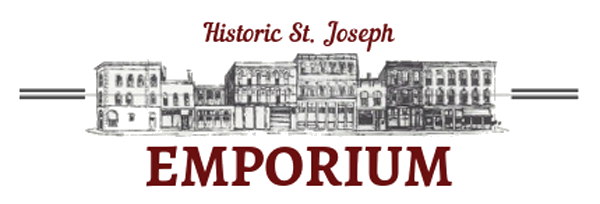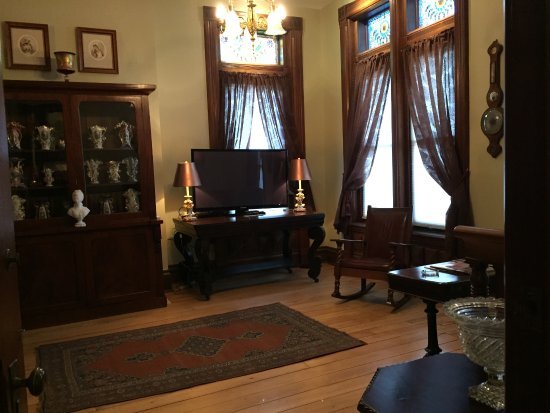Market Square
Shakespeare Chateau and Gardens
On the evening of January 12, 1888 Elmerine and Nathan Ogden threw open the doors of their extraordinary home at 809 Hall Street to several hundred of the social elite of St. Joseph. The privileged guests were treated to a lovely supper in the dining room that was described by the local newspaper covering the evening as, “a fit place to make the epicure feel that during his life he had merely heard of the good things of life, yet had been unable to partake of them.”
Today you can partake of all of the luxuries that the Ogden Home, better known as the Shakespeare Chateau, has to offer. Whether you are looking for a relaxing weekend getaway, a place to hold a business meeting, or a magical place for a wedding the Chateau will make your time there unforgettable!
The Shakespeare Chateau, so-called because of the bust of William Shakespeare above the front foyer fireplace, boasts 47 original stained glass windows, elaborate fireplace mantles with the original tilework still in place, and carved cherry, mahogany, oak, and walnut woodwork throughout. The first floor music room has a stunning set of intact Zuber wallpaper (one of the other places you can find such a set is in the White House).
The luxuriously appointed guestrooms each have lovely art and antiques, HDTV with BluRay player, fee WiFi, and private baths with jetted tubs and a luxury Euro-spa shower. Your mornings will begin with a delicious gourmet breakfast.
The Chateau sits in the midst of the Hall Street Historic District, once known as “Millionaires’ Row.” Here some of the most extraordinary mansion homes in St. Joseph can be found. An evening stroll along the sidewalks in this neighborhood will transport you back to a time of elaborate gowns and horse-drawn carriages.
The Inn Keeper, Isobel McGowan is a leading force for preservation in St. Joseph. Her work on behalf of the historic buildings of St. Joseph began when she purchased the Chateau, then described as a “distressed building” in 2012 and meticulously restored it to the glory that we see today. Isobel has served as the Chair of the Landmarks Commission (the city board tasked with overseeing the local historic districts), President of the Historic St. Joseph Foundation, and the founder and President of the Old Town North Neighborhood Association.
The Shakespeare Chateau provides a gracious setting for your next holiday or event and is a perfect home-base from which to explore all that St. Joseph and the surrounding area has to offer.
Location: 809 Hall St., St. Joseph, MO - Visit: www.shakespearechateau.com - Call today to reserve your stay: (816) 232-2667.
Tours of Historic St. Joseph
Book Tours at www.AirBnB.com click Experience. Search St. Joseph, MO
St. Joseph, Missouri is a small city with a big history and much of that history happened in the historic neighborhoods. There is no one more well-placed to guide you through that history than Jerry Reeves. Jerry is a 5th generation St. Joseph citizen with roots that go back to the beginnings of the city and some of its most important citizens. His great-great grandfather was Henry Krug Sr., the benefactor of Krug Park and one of the most successful early St. Joseph businessmen.
Under Jerry’s guidance you can book one or both of these tours at : http://www.AirBnB.com. click Experience. Search St. Joseph, MO:
1. Museum Hill and the Wyeth-Tootle Mansion
2. Krug Park Place and the Henry Krug Jr. House
Museum Hill and the Wyeth-Tootle Mansion: Meet at the front of the magnificent Wyeth-Tootle Mansion at 11th and Charles to begin your stroll back through time to the golden age of St. Joseph History. The Mansion, located at the heart of the historic Museum Hill National Historic District, is the epitome of golden-age St. Joseph. Designed by renowned architect E.J. Eckel in 1879 for William Wyeth and his wife, the mansion deliberately evokes the feeling of European castles – a clear sign of the wealth and confidence that characterized the booming city at that time.
the evocative wyeth-tootle mansion
Jerry will lead you around the district where you will see a wide range of architecture: from houses on the scale of the Wyeth-Tootle to much more modest working class dwellings. You will learn about the people who built and worked in those houses and the role that they played in the history of St. Joseph as well as the architectural styles exemplified in the wonderful homes of the district.
Jerry will take groups into the Wyeth-Tootle, now a site of the St. Joseph Museums, Inc. where a changing range of exhibits will further illuminate the history of St. Joseph.
Krug Park Place and the Henry Krug Jr. House: Groups meet Jerry in the garden of the Henry Krug Jr. House at 1105 Krug Park Place to tour this house and district that are deeply linked to the history of Jerry’s family.
Krug Park Place is a National Historic District and was designed by Henry Krug, Jr. as an exclusive enclave on the then edge of the city. He built the first house in the district at 1105 and over the next few decades the other houses came to occupy the spacious lots along the tree-lined street.
Henry Krug Jr. (1861-1946) followed in his father’s footsteps as a successful St. Joseph businessman. He was deeply civic-minded serving on the school board, the library board, the national governing council of the boy scouts, and the board of the YMCA. He and his wife Selma engaged E.J. Eckel to build their impressive home in 1892.
As the district grew, Krug was joined by members of his family as well as other prominent businessmen. The houses that they built are reflections of the role that they played in the St. Joseph community.
Henry Krug Jr’s house stands at the heart of a unique historic district
Inside the Henry Krug Jr. house you will get a real taste of what the house was like when Henry and Selma lived there: original Krug furniture and memorabilia remain in place. Jerry, who spent some of his childhood in the house, will talk about the family and the history of the home as it went from being a cherished family residence, to an apartment house, to an abandoned derelict structure, and then through restoration and back in to the Krug family.
St. Joseph is a city of many stories and wonderful things to see. Join Jerry on one of his tours and get to know this historic town a bit better!
Step Back to the Beginning of St. Joseph at Robidoux Row Museum & Event Space
One of the oldest Structures in St. Joseph, Robidoux Row is the only remaining building that was built by Joseph Robidoux
Robidoux Row
219 E. Poulin
Museum Hours of Operation: Wed – Sat: 10-4, Sun-Tues: closed
For Rental Information: 816-232-5861, sjhsatrr@gmail.com
https://www.robidouxrowmuseum.org/
St. Joseph is a city that is full of history and one that certainly pays homage to its founder Joseph Robidoux. However, there are relatively few places in the city where you can experience the surroundings much as Joe would have known them.
One of those few places is Robidoux Row. Joseph Robidoux had this building constructed during the 1840s and 1850s and it is a testament to his canny ability as a businessman. During this period, the new city of St. Joseph was being platted and was growing rapidly. As new settlers came to town, they often needed a place to stay until they had built permanent residences for themselves. If a family purchased a plot of land from Joe, he would provide them with temporary accommodations at Robidoux Row until their house was built. For this reason, some have classified the Row as the “oldest or first apartment house west of the Mississippi.”
The living arrangements at the Row were not luxurious; a family and their possessions occupied one room. Outdoor privies served bathroom needs, and in all but the most inclemate weather, most of the cooking would have been done outside. The rooms were heated by iron stoves which could be connected in to the chimney in each room.
Seeing the appeal of downsizing, Joseph Robidoux himself moved in to the east apartment following the death of his wife Angelique in 1857. He spent the remainder of his life there, dying in the same apartment on May 27, 1868. His final years had not been kind to the founder of St. Joseph – he died blind and broke.
As the housing needs of the booming St. Joseph changed, so did the occupants of Robidoux Row. It became low-income apartments for a wide variety of working class citizens. The occupants of the increasingly dilapidated structure for the first half of the 20th century worked for most of the industries that were fueling the economic growth of St. Joseph.
By the mid 20th Century, robidoux row was serving as low-income housing and was increasingly distressed
In 1899 John E. Wolfley, a harness maker for Wyeth Hardware Co. shared apartment 223 with the painter, Walter J. Williams. In 1915, John and Hazel Cluster moved in to apartment 211. Both worked a variety of jobs for various of the dry goods companies in town.
At times, Robidoux Row was a very female place. Because the rent was low, it was affordable for widows who were on very limited incomes. Some of these women, such as Jeanette Williams, who lived in apartment 227, supplemented their income by working as laundresses.
By 1907, most of the occupants of Robidoux Row were African American, thus the Row provides a window on to a part of St. Joseph history that remains largely unexplored. For many years Strother Beshears lived in apartment 227 with his family including his son Rufus. The Beshears family was one of the most important in the history of the African American experience in St. Joseph. Strother worked as a laborer and porter for Neudorff Hardware, but he had bigger dreams for his children. His son Rufus became a prominent dentist and married civil rights campaigner Kelsey Beshears.
By the 1970s, Robidoux Row was in sorry shape and was threatened with demolition. As the threat became imminent some of the earliest historic preservation campaigners in St. Joseph became determined to save it. Mary Stauber Boder and Barbara Ide worked with the Saint Joseph Historical Society to save the last remaining structure built by the founder of St. Joseph.
This was not a project for those faint of heart. Only one floor (in the southwest room) was in good enough shape to be preserved. The interior was so damaged that it had to be entirely gutted and rebuilt. Some of the exterior walls also had to be rebuilt.
But the challenge was also an opportunity. As the restoration work was underway, an archeological dig took place. The researchers found the original floor of the north porch and clarified the location of the well and privies that serviced the early inhabitants. A large number of artifacts were uncovered and they form an important part of the exhibits of the current museum.
Restoration continued and in 1981, before the work was completed, Robidoux Row opened to the public as a museum. Today the museum continues to tell its unique story and the building can be rented as a never-to-be-forgotten events space.
Understanding its vital role in the fight to preserve St. Joseph’s historic structures, Robidoux Row has recently opened an exhibit featuring three of the great preservation challenges that the city has faced: the Row itself, the Cracker House, and the Livestock Exchange. Using artifacts and technology, the exhibit tells the story of the struggle to preserve these iconic structures and why preservation is a vital endeavor.
Learn more about Robidoux Row and the earliest years of St. Joseph at Old Saint Jo on YouTube https://www.youtube.com/watch?v=Aab8Z9cQ7jw&t=563s
Visit Robidoux Row for a unique view into the earliest days of this historic city!

















